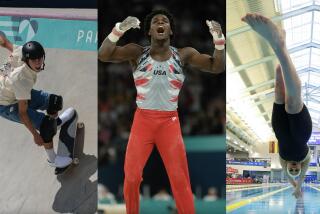Propelled by a Will to Win : In or Out of the Pool, Larsen Full of Fight
- Share via
Like the cuddly stuffed tigers she clutches at swim meets, Alexis Larsen is adorable. Her conversation is sprinkled with giggles and she greets strangers and friends with a shy smile.
Yet the competitive side of Larsen’s personality is akin to the flesh-eating tigers which roam the grasslands of Nepal. She is fierce, relentless, and she carries the tigers as symbols of her unyielding nature.
A scowl replaces the swimmer’s nervous giggle when she describes her will to win.
“I just can’t stand it when someone beats me,” said Larsen, who will begin her senior year at Harvard-Westlake High in the fall. “It’s so irritating. You just get so mad, you have to beat them.”
Larsen, 16, has the eye of the tiger. Seemingly, she won’t allow anything--including a hyperactive thyroid--halt her rise from flailing 8-and-under to national champion.
Her coach, Bud McAllister, of Calabasas-based CLASS Aquatics, believes she was born with a competitive mentality.
Her mother, Shelby, subscribes to the nurture theory.
Shelby Larsen believes that all those summers spent sinking to the bottom, hanging onto the lane ropes, and finishing races after the other swimmers hoisted themselves out of the pool instilled in her daughter a loathing of losing.
Certain of her last-place fate, Larsen rarely entered meets, yet she happily sloshed through the practices. In similar fashion, she did not distinguish herself in tap dancing class, cello recitals, T-Ball games or soccer matches.
By 1989, one year after the Larsen family moved from Connecticut to Pacific Palisades, Alexis dropped all of her other pursuits for swimming.
She switched from Team Santa Monica to CLASS a year later. Although McAllister told her developmental swimmers were expected to attend nine practices a week, she insisted on attending 11.
“There may be kids with a lot more talent,” she told McAllister, “but I will work harder.”
The extra practices, an increase in yardage and intensity, and McAllister’s decision--based on Larsen’s lack of speed--to transform her from a sprinter to a distance freestyler, led to extraordinary improvement.
In four months, she went from local qualifying-meet participant to national-championship qualifier, becoming one of a handful of American swimmers to bypass the zone and junior national time standards in posting her first national time standards.
Suddenly, Larsen’s view of herself as a swimmer was askew.
“It was really weird,” she said. “I guess I never really thought about myself being that good.”
Unfortunately, her view from the top was blocked two months later by more pressing concerns.
During a strep test, Peter Jensen, Larsen’s family doctor, discovered a small nodule on her thyroid gland. It was not cancerous, but other tests showed the early stages of a hyperactive thyroid. Given the choice between radiation therapy and surgery, the Larsens chose surgery.
When they broke the news to Alexis, she wept.
“I cried because I thought I’d never be able to swim again or that I’d never be able to swim as fast,” she said.
In tigress fashion, she dried her tears, set her jaw, and scheduled her operation for the only week in August between the national championships and the start of her sophomore year.
In the four-month interim, she took propylthiouracil, a drug that suppresses the thyroid hormone. That hormone governs metabolic rate and the activities of most of the cells in the body.
Left undetected, as was the case with Olympic sprinter Gail Devers, a thyroid disorder can cause fatigue, weight loss, menstrual irregularities and hair loss.
The drug left Larsen sluggish. Her muscles tired easily, she had difficulty recovering between practice sessions and her endurance waned. Yet her plucky attitude and adherence to the demanding practice schedule paid off.
Inspired by a boisterous, overflow crowd at USC in July, 1991, she lowered her career best in the 400-meter freestyle to 4 minutes 16.89 seconds in a second-place finish at the U.S. Olympic Festival.
A few weeks later, surgeons removed half of her thyroid, leaving a thin scar across her slender neck. True to her unflappable nature, Larsen is oblivious to the necklace-shaped reminder of her ordeal.
“A lot of people ask me about it,” she said. “I don’t care. I never really think about it.”
Because of the operation, her thyroid is underactive. For the rest of her life, she must account for 50% of the hormone her thyroid no longer produces by taking a daily dosage of synthroid, a replacement hormone.
Larsen began taking synthroid in November, 1991, but it took nearly a year to pinpoint a dosage that would allow her to train at a world-class level.
Too much or too little synthroid left Larsen with the same listless feeling. Four hours of distance freestyle did the same thing. Consequently, she couldn’t distinguish between the fatigue caused by training and the fatigue caused by the wrong dosage.
“I tried not to blame anything on the medication,” she said.
McAllister was nearly as frustrated. “She was terribly slow,” he said. “I didn’t know whether to yell at her or not.”
Every time malaise set in, Larsen squeezed an appointment with Jensen between school and her twice-daily swimming practices.
“She didn’t fixate on it,” Jensen said. “You could be driven to hypochondria. It is normal to have ups and downs, but you don’t want it to dominate her life.”
Each dosage change required a two-week adjustment period that threw off her practice sessions. Often, Larsen lagged so far behind that she couldn’t make the intervals McAllister prescribed.
“She just kept on going,” teammate Kristine Quance said. “She just kept trying to catch up.”
Shelby Larsen feared her daughter eventually would see herself as a flash in the pan and give up her swimming career. Her spirit proved indomitable, however.
“She never got out early and she never once gave up,” Shelby said. “She just got in and swam, fast or slow.”
Four months after embarking on her wild ride on synthroid, Larsen competed in the 1992 U.S. Olympic trials, placing sixth in the 800-meter freestyle in a career-best 8:43.74.
The top two finishers, Janet Evans and Erika Hansen, went on to Barcelona where Evans won a gold medal.
With Evans wrapping up a post-Olympic victory tour last August, Larsen won her first national title, taking the 1,500 freestyle (16:36.92). She also finished third in the 400 freestyle (4:15.63) and the 800 freestyle (8:41.02).
Her times in all three events were career bests despite her time-consuming and frustrating attempts to find the proper medicinal dosage. Since September, Larsen’s dosage and training have been consistent, enabling her to concentrate on opposing swimmers rather than medicine.
At the Southern Section Division 3-A championships in May, Larsen worked herself into a frenzy over Ginny Farmer of San Luis Obispo High. Moments after Larsen knocked four seconds off her best time to break the section record in the preliminaries of the 200-yard individual medley, Farmer broke the record.
“I was so mad,” Larsen said. “It was hard. You have to wait all day to swim again and you’re thinking, ‘What if I don’t beat her? What if I do beat her?’ It’s the worst.”
The following night in the finals, Larsen shaved two seconds off the record and triumphed over Farmer, securing her fifth Southern Section title.
She showed similar tenacity two weeks ago at a national high-altitude training camp in Flagstaff, Ariz.
As a test during one practice, the coaches gave the women’s group consecutive sets at an interval barely within their speed. On the second set, all of the women gave up except Larsen and Sarah L. Anderson of San Ramon-Livermore Aquatics.
“Mentally, Alexis and Sarah were tougher than the others,” McAllister said.
Larsen’s view of the lung-burning, heart-pounding session?
“Well, I didn’t want to let Sarah beat me,” she said. “I could see the others were giving up and I figured that when you are going that fast and beating them, it will help you down the line. You always want to prove to people that you are better than they think you are.”
Yet such proof can be disconcerting.
“It’s kind of scary because you know how much hard work it takes,” she said. “When you go to a (national) camp or nationals, you see the competition and you realize you gotta work hard because they are all out there working hard.”
After a warm-up, today through Sunday in the Janet Evans Invitational at USC, Larsen is aiming for a peak performance in the national championships July 26-30 in Austin, Tex.
This time Evans will be in the water, and berths are on the line for the team that will represent the United States in the Pan Pacific championships next month in Kobe, Japan.
Tigers are not found in Japan, but be sure that if Larsen makes the team, she will bring along her stuffed collection as well as her ferocious approach to swimming.
More to Read
Go beyond the scoreboard
Get the latest on L.A.'s teams in the daily Sports Report newsletter.
You may occasionally receive promotional content from the Los Angeles Times.










